Reasons to visit Kutaisi, Georgia’s third-largest city and one of oldest in the world
Although many visitors arriving in Georgia by air come into Kutaisi’s international airport (it is the main hub for most low-cost carriers including Wizz Air), the majority transfer directly from the terminal to either the capital, Tbilisi, or west to the coastal city of Batumi.
For many, Kutaisi, Georgia’s third-largest metropolis and former legislative capital, isn’t part of their Caucasus travel plans but from relaxed city meanderings to monastery-bashing and urbexing to highly-recommendable day trips, we can think of several good reasons why spending time in and around Kutaisi is a worthwhile experience.
Where is Kutaisi?
Kutaisi is 230kms west of Tbilisi and 145kms northeast of Batumi. It is the capital of the western Imereti region of the country and is situated on the banks of the Rioni River.
Kutaisi is considered one of the oldest cities in the world and archaeological evidence indicates that the settlement served as a political centre as well as a capital of the ancient kingdom known as Colchis, a prehistoric region that dates back to the 17th century BCE. Centred on the Black Sea coast and associated with the Argonauts (as in Jason and the …), Colchis is often viewed as the origins of the nation of Georgia.
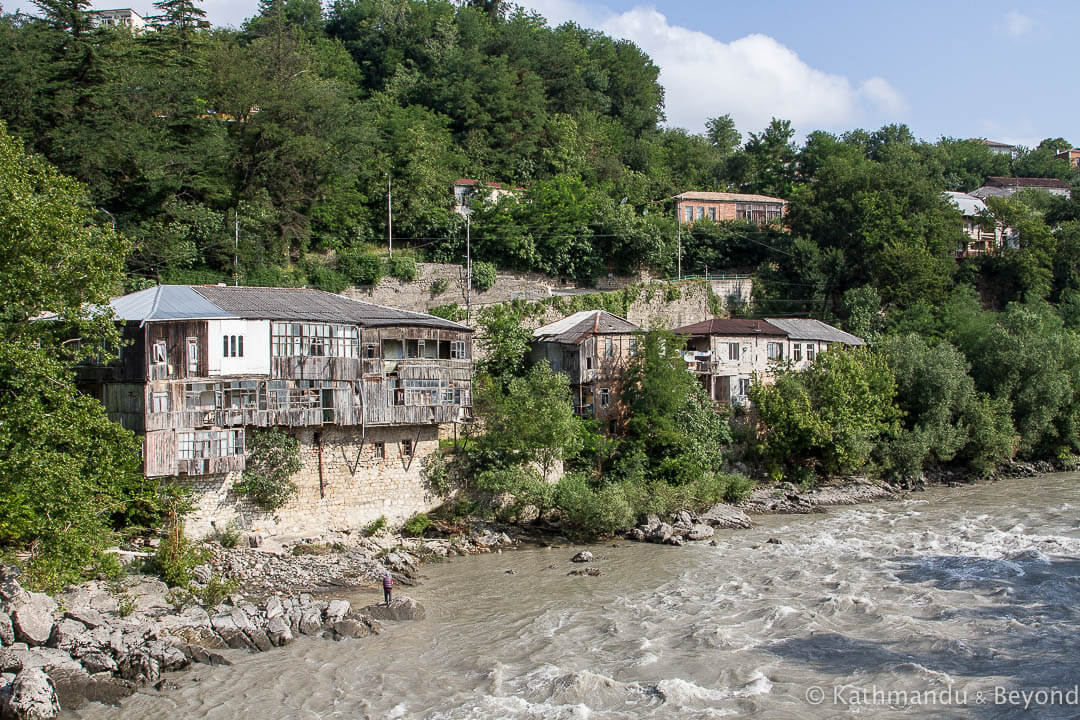
What to see in Kutaisi
Admittedly, Kutaisi itself isn’t that exciting at first glance. It is a bit of a sleepy backwater, albeit a charming one, and can’t be compared with either Tbilisi or Batumi when it comes to city buzz. But, as you wade your way through our guide to Kutaisi you will discover the city itself should be thought of as part of an overall ‘Kutaisi package’ rather than a stand-alone destination in its own right.
That said, there are definitely enough things to see and do in Kutaisi city centre to keep you occupied for at least a day or so. Plus, with its leafy central park, hilltop amusement park, and riverside setting, downtown Kutaisi is also a pleasant place to while away additional hours of the day, particularly if it is warm and sunny.
On top of that, if you are interested in architecture, monuments and mosaics from Georgia’s Soviet past then you can easily spend another day exploring the outskirts of the city in search of such relics. Check out our dedicated post about Soviet-era architecture, monuments and mosaics in Kutaisi for the lowdown on what we found in the city along with a map pinpointing the locations.
Some of the vestiges from Kutaisi’s Soviet era are centrally located and thus included in the suggested walking tour that follows. However, they are only briefly mentioned and more information can be found in the Soviet-era architecture, monuments and mosaics Kutaisi post. Click on the link where prompted to be redirected.
Map of Kutaisi attractions
Kutaisi walking tour
Agmashenebeli Square is the logical place to begin an orientation tour of Kutaisi. The centrepiece of the square is the Colchis Fountain, which has been in situ since 2011.
Visible behind the fountain is the Lado Meskhishvili Theatre. With a history dating back to 1861, the theatre is one of the oldest of its kind in Georgia, although this particular building was completed in the 1950s and is a good example of Stalinist Empire-style architecture.
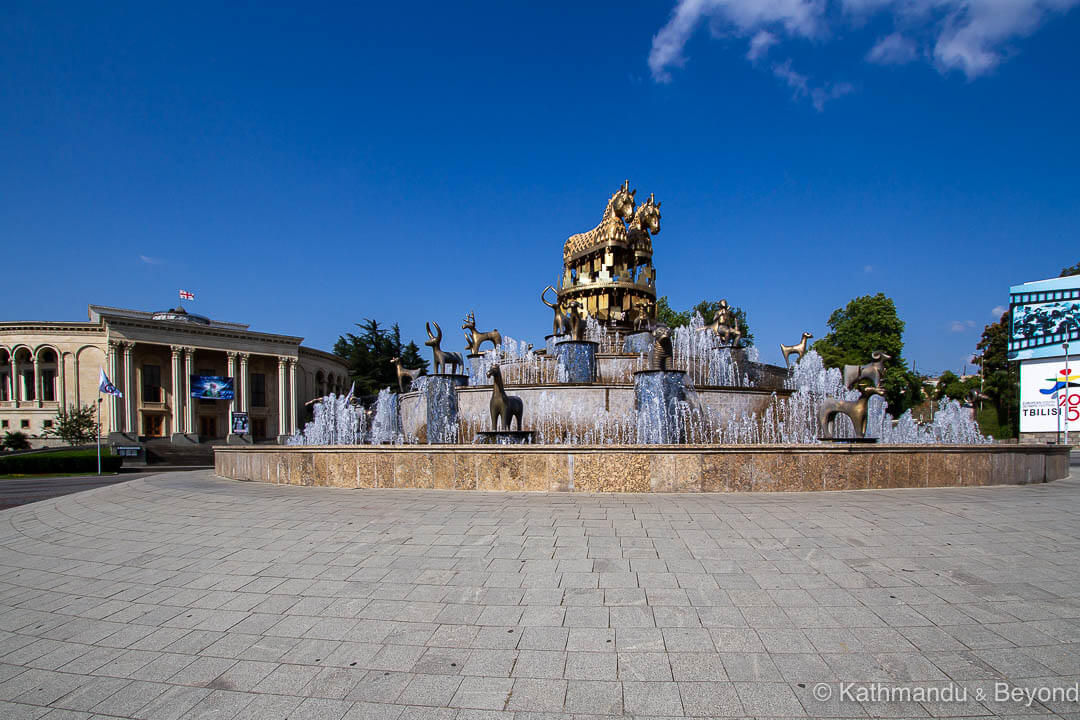
Heading north, pause at the National Museum of Military Glory before crossing the Rioni River and winding your way up Ukimerioni Hill to the city’s most important house of worship, the early 11th-century Bagrati Cathedral. Along with Gelati Monastery (see day trips from Kutaisi section below), Bagrati Cathedral used to be listed as a UNESCO World Heritage site. Awarded the status in 1994, the accolade was taken away from Bagrati (but not Gelati) in 2017 after the organisation disagreed with controversial restoration work that went ahead on the cathedral, which included the bolting on of a metal and glass box-like structure to the original masonry. Still, the cathedral remains one of the city’s most impressive sights and is worth walking up the hill to see.
Should you wish to visit it, the Botanical Garden is around 700 metres east of Bagrati Cathedral.
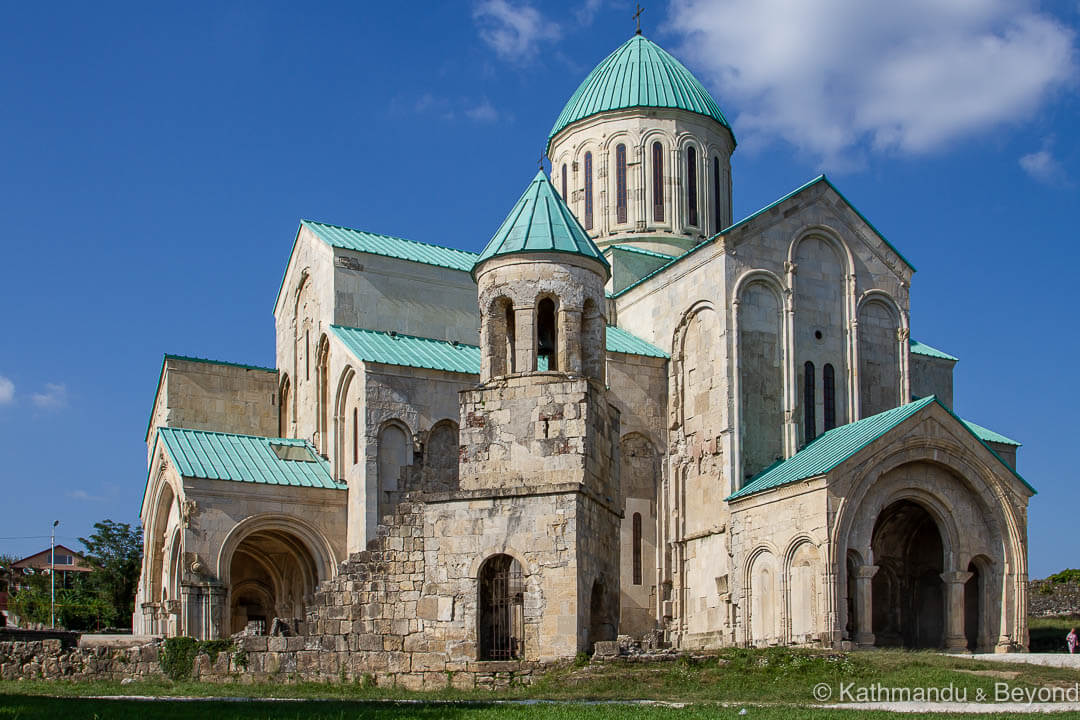
Being elevated, it makes sense to stay high and continue southwest along Kazbegi Street to Besik Gabashvili Amusement Park. Depending on the time of day and season (we were there in the early afternoon in winter so it was devoid of any people), the park is a good place for a spot of people-watching plus there are a few antiquated rides including a colourful Ferris wheel that looks like it dates from the country’s Soviet period but may not be that old!
There is the option to return to the centre of Kutaisi via the city’s one-line cable car system. The upper station is situated in the park and will take you down to the lower station which is close to the pedestrianised White Bridge. Continuing with the walking tour, however, there are two sets of steps just to the left of the upper cable car station that will take you down through the forest to the east bank of the Rioni River. Take the lefthand set of stairs to be on the safe side – it may well have been because it was winter when we were in the park but the exit gate at the bottom of the righthand side set of steps was firmly padlocked when we got there and so, annoyingly, we had to go back up and take the stairway that veered to the left.
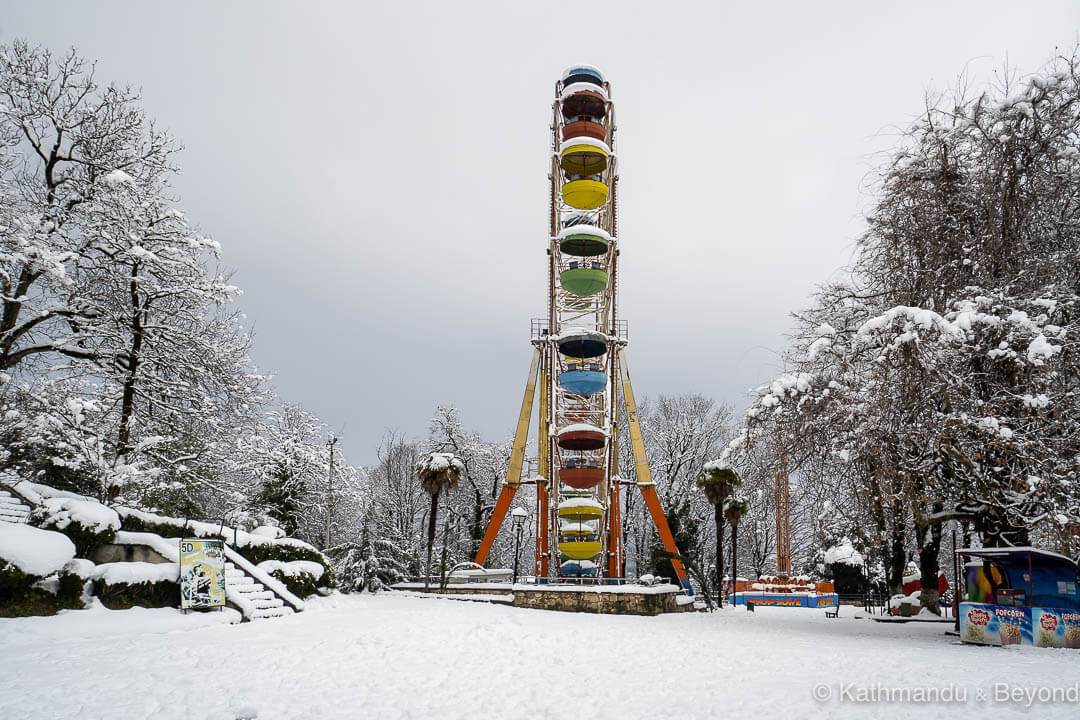
Just before exiting the stairway, there is the first of two monuments along this stretch of road dedicated to two of Georgia’s most famous poets/writers. The first, at the foot of the stairs, is a stone bust of Vazha-Pshavela and, just past the turnoff for the Red Bridge, is the Monument to Galaktion Tabidze. Both monuments were created in the latter years of the Georgian SSR and more information can be found in our Soviet-era architecture, monuments and mosaics in Kutaisi post.
Back on the town side of the Rioni River, Green Market is the next city landmark of note. The baazar is typical of any covered market in this part of the world – noisy, a little hectic and a fun place to be. Also, check out the fantastically ornate ceramic panel at the western entrance to the market. It dates from Soviet times and is entitled “Kolkheti”, or more commonly “Colchis”.
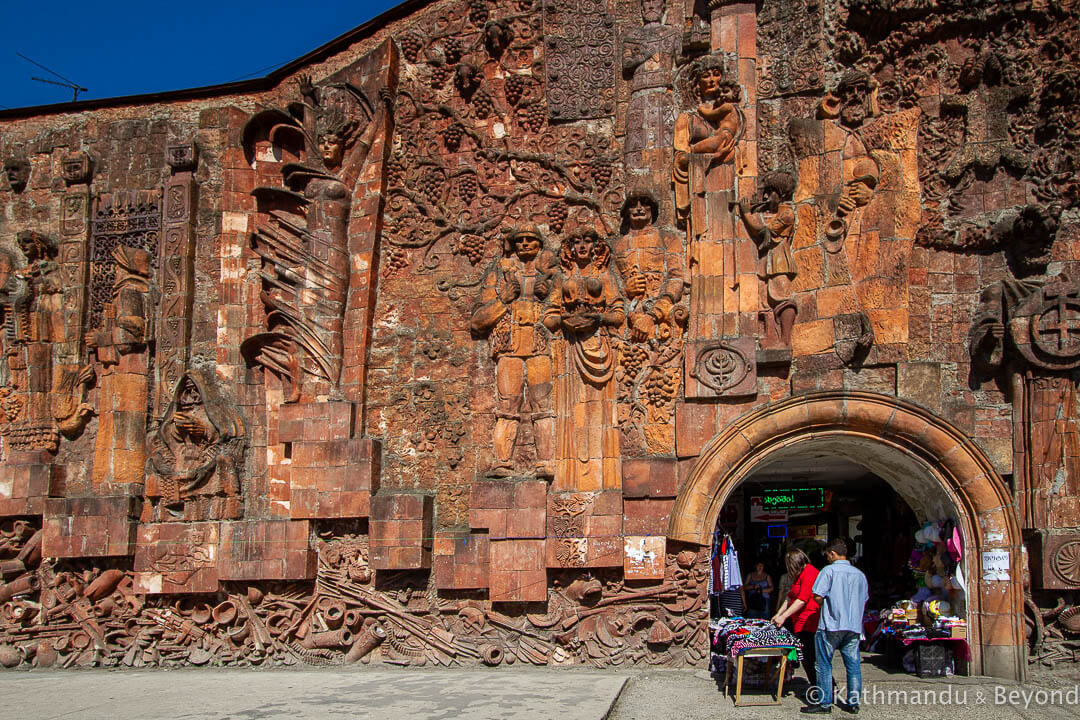
The central park is more or less opposite the eastern entrance to the market, should you want to hang out there for a bit.
In case you need on-the-ground information, the very helpful tourist board is just east of Rustaveli Bridge. The staff speak English and can assist with queries about the city as well as other attractions in the Imereti region. The staff are also knowledgable about public transport.
Heading back in the direction of Agmashenebeli Square, the abstract Glory to Labour Monument is another memorial erected during Georgia’s Soviet period. From this point, it is a short walk to a piece of street art by the French artist known as Vinie. It got Kirsty very excited as she had never seen a Vinie ‘in the flesh’ up until this point!
Another place of interest in the centre of Kutaisi is the Kutaisi State Historical Museum. We haven’t visited it personally, but it is marked on the above map.
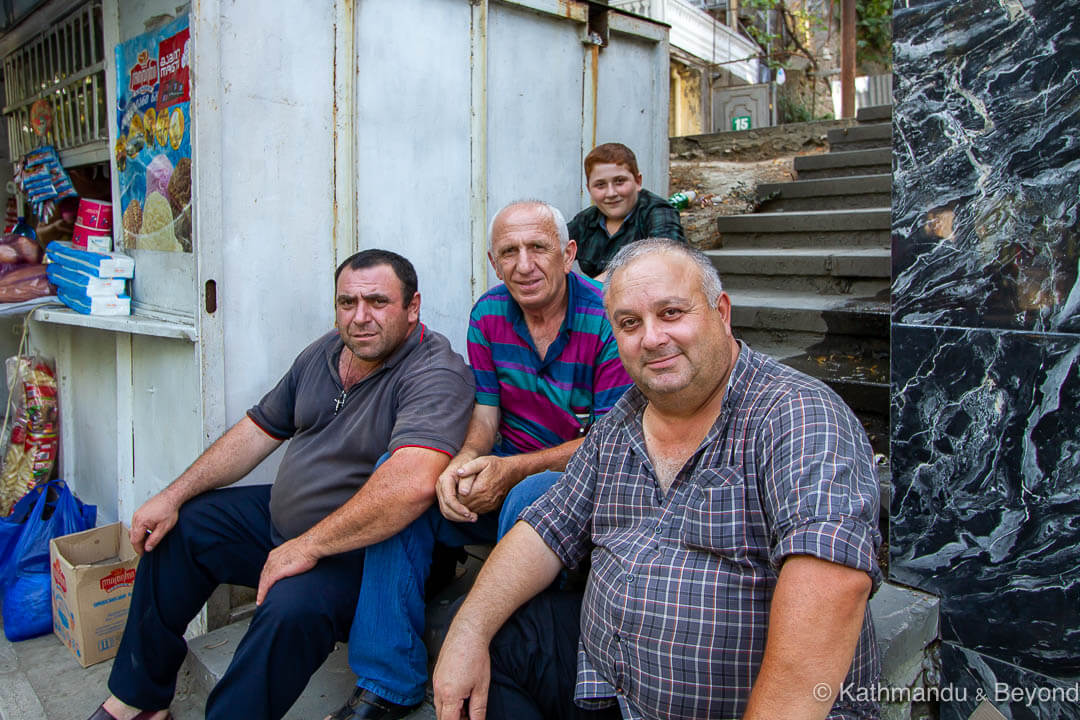
Places of interest away from the centre of Kutaisi
The former building of the Georgian Parliament is worth a visit if you are a fan of contemporary architecture. In an attempt to decentralise power and spread economic development, the newly elected government at the time relocated the Parliament of Georgia to this purpose-built building in 2012, where it remained until early 2019 when it moved back to Tbilisi once more. There was talk that the glass-domed structure would be handed over to the Ministry of Internal Affairs and become a regional police hub for Western Georgia but, to date, that has not transpired and the building remains vacant.
The parliamentary building was designed by the Spanish architectural firm, CMD Ingenieros, and, controversially, a large memorial dedicated to Soviet soldiers who lost their lives during World War II was demolished to make way for its construction.
If you are in the centre of Kutaisi, unless you want to a long walk (an hour or more), you will either need to take a local bus or a marshrutka (fixed route minivan) to see the former building of the Georgian Parliament. We jumped on a passing marshrutka headed in that direction, but if you want more certainty, take bus #4 from the marshrutka stand located on the edge of town on Shota Rustaveli Avenue (marked on our map). It’s less than a 10-minute walk from Rustaveli Bridge, but if you are coming from further afield into town, you can take the #1 bus which runs a circular route and passes the marshrutka stand.
Alternatively, if you find yourself down on Chavchavadze Avenue, the road on which the main bus station is situated (you will be if you are also using our Soviet-era architecture, monuments and mosaics in Kutaisi post) then the parliament building is approximately 1.4kms/15-minute walk from there.
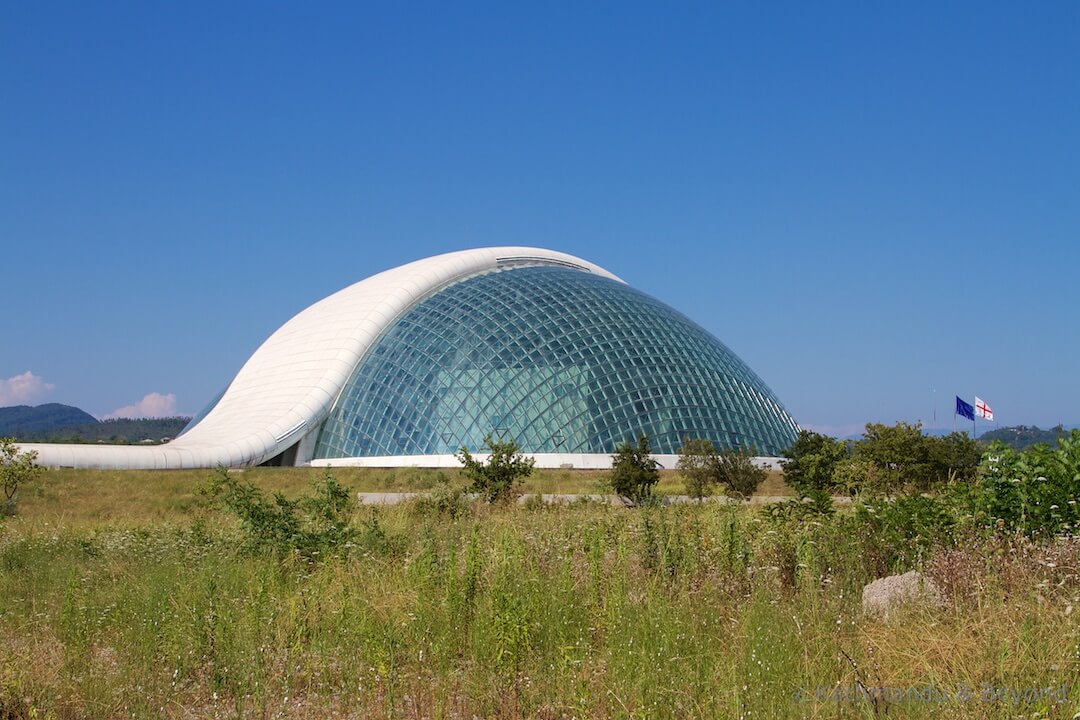
Up until a few years ago, very little street art could be found in Kutaisi. The most notable piece is a colourful mural by Vinie (as mentioned above), although this is looking a little faded these days. However, during our winter 2022 trip to Kutaisi, we noticed more and more street art and interesting graffiti popping up. One of the best places in Kutaisi for street art is out at Kutaisi International University (KIU) where a project called KIU Mural Fest launched in 2020. It’s a bit of a hike from downtown Kutaisi but the large-scale murals from International artists like Artez, Innerfields and Case Maclaim are worth seeing. City bus number 3 will get you from the centre of Kutaisi to the university.
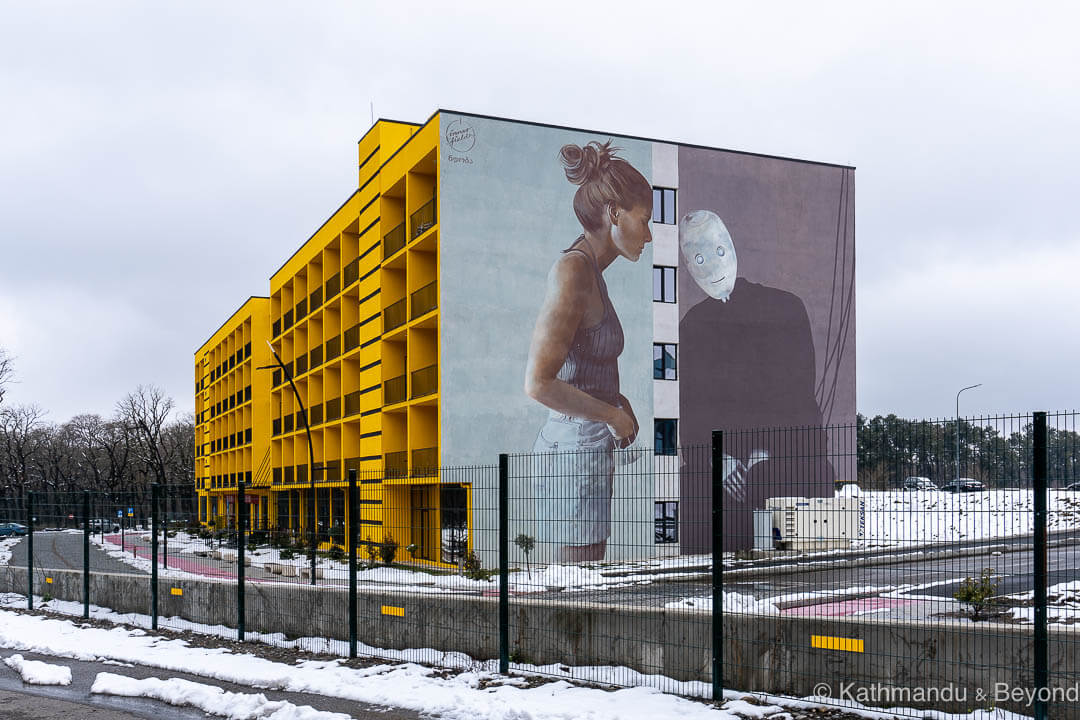
Day trips from Kutaisi
Great day trips are Kutaisi’s trump card, in our opinion, and the main reason to spend extended time in the city.
Abandoned Sanatoriums in Tskaltubo
Unquestionably, the most compelling day trip you can take from Kutaisi is to the spa town of Tskaltubo. To quantify this statement, you do need to be interested in abandoned places and/or Stalinist Empire-style architecture to fully appreciate the place. The town is easy to get to from Kutaisi (20 minutes by marshrutka) and once there, the places of interest are accessible on foot. These include fully and quasi-abandoned sanatoriums, overgrown bathhouses, Soviet-era mosaics and a former dacha (holiday cottage) used by the Soviet dictator, Joseph Stalin. Furthermore, Tskaltubo is still an active spa town and it is possible to undergo treatment in one of the town’s handful of functioning bathhouses or sanatoriums.
There are some ethical considerations to take into account if you do decide to visit Tskaltubo as some of the former sanatoriums and hotels are occupied by Internally Displaced Persons (IDPs). The majority of the IDPs sought temporary refuge in the town during and after the Georgia-Abkhazia War, an ethnic and territorial conflict which lasted from August 1992 until September 1993, and IDPs are still living there today. Hence, a degree of sensitivity is required if you go near any of the buildings occupied by IDPs. But, overall, the local people we have met during our time there (we have visited on several occasions) have been friendly and welcoming and we consider Tskaltubo to be one of the highlights of our entire time spent in the Caucasus region, a period which amounts to several months in total.
We have written a more detailed post about Tskaltubo, which delves into the history of the town, what there is to see and do as well as practicalities such as transport options. In Kutaisi, the most convenient marshrutkas for Tskaltubo depart from nearby the Monument to Galaktion Tabidze, the other side of Red Bridge.
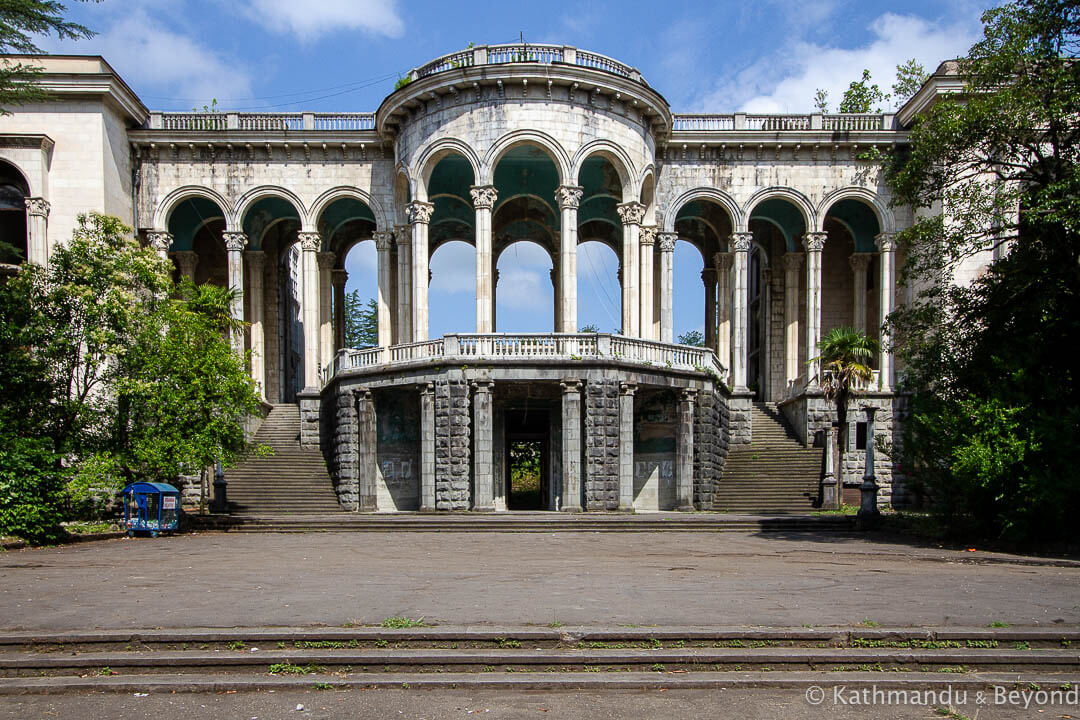
Prometheus Cave
Prometheus Cave, also known as Kumistavi Cave, is just 6kms north of Tskaltubo. Caves aren’t really a ‘thing’ for us and we haven’t visited this one but, it is an easy day trip from Kutaisi if you enjoy visiting underground karst systems. The options for visiting Prometheus Cave are either to take an organised tour directly from Kutaisi (the tourist information centre can help with recommendations) or, alternatively, you can make your own way there by first taking a marshrutka to Tskaltubo and then another one from there to the cave entrance. On arrival, you will have to join a guided tour (individuals and small parties are amalgamated into one group) to enter the 1.2km long cave and the whole excursion inside lasts around one hour.
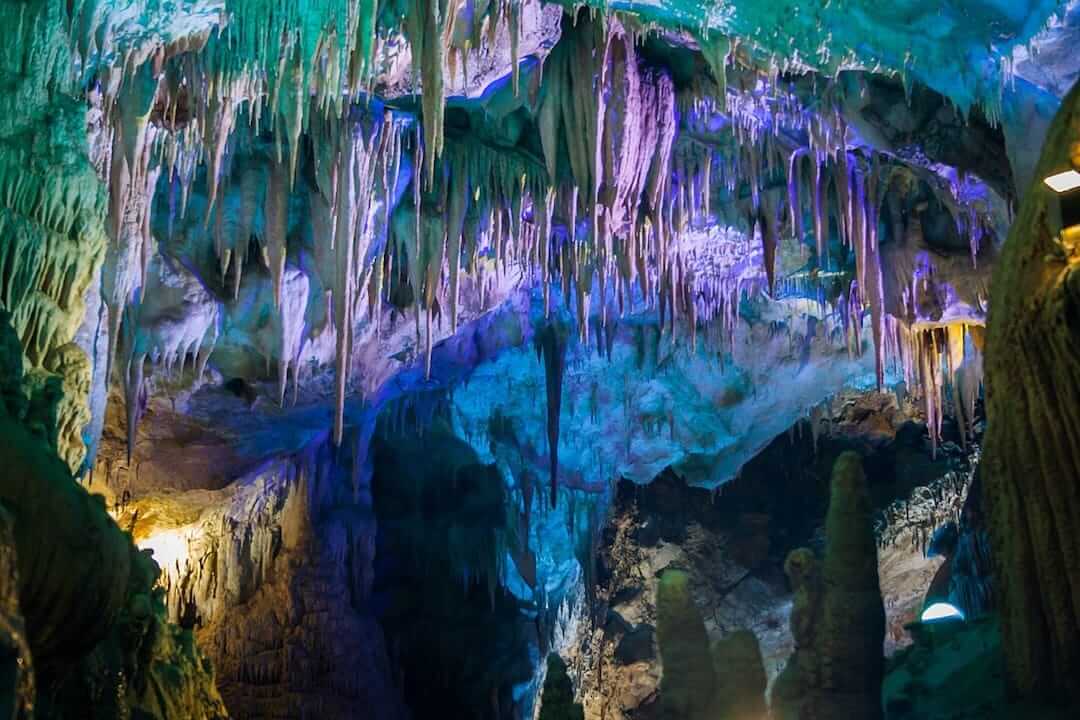
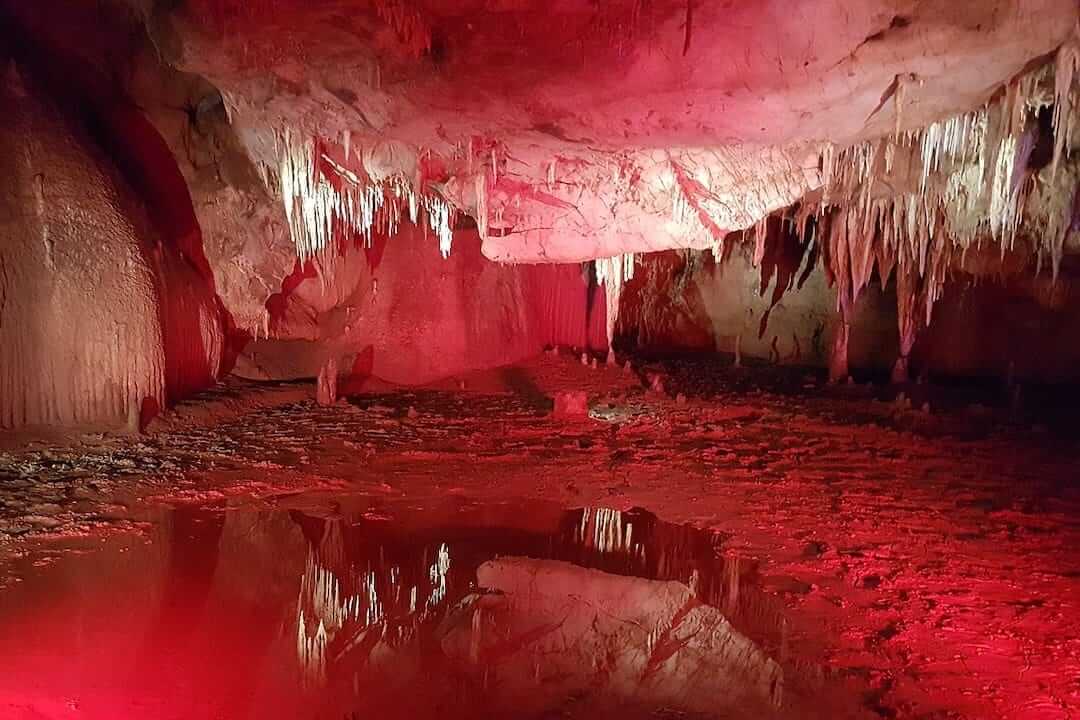
Gelati and Motsameta monasteries (combined visit)
Gelati Monastery
Hailed as a ‘second Jerusalem’ by medieval chroniclers (because of its academia), this important monastic complex isn’t especially remarkable when viewed from the outside but what makes it stand out from other Orthodox churches in Georgia are the vivid frescos that adorn the interior walls. Work on the monastery was started in 1106 by King David IV (1073-1125), better known as David the Builder, during a period when Georgia was experiencing its ‘golden age’ – a time of political strength and economic prosperity. Several Georgian rulers, including David the Builder, are buried here and the murals, which were painted from the 12th to the 17th century, feature noble figures such as the Byzantine emperor Constantine, the Georgian king Bagrat III as well as King David himself. The most notable artwork is a mosaic in the main Cathedral of the Virgin depicting the Virgin with Child flanked by archangels Michael and Gabriel.
Be prepared for a (varying) degree of renovation work to be taking place when you visit the monastery as it is continually being restored and protected under the supervision of UNESCO.
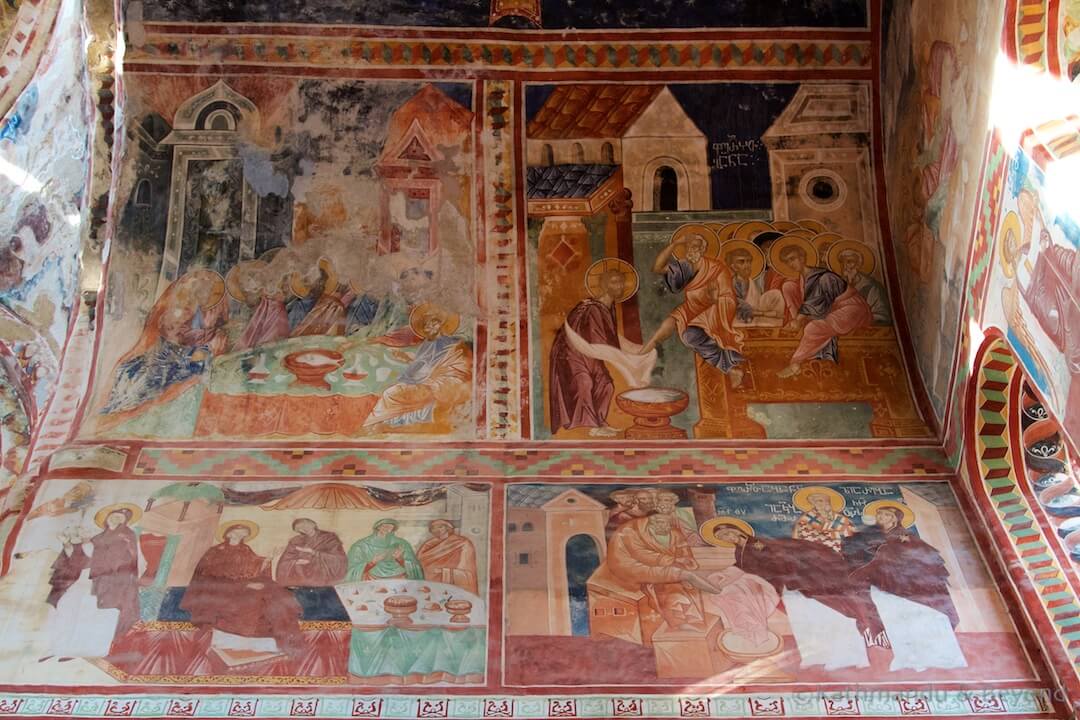
Motsameta Monastery
If Gelati is renowned for its frescos then Motsameta Monastery is all about its sublime clifftop setting above a bend of the Ckalcitela River. The name of the monastery translates as “Place of the Martyrs” or “Place of the Tortured” and Ckalcitela means “red water”. According to history, in the 8th century two brothers, David and Constantine, from the noble family of Argveti, raised a rebellion against the then-occupying Arabs. The uprising failed and in return for converting to Islam, the two brothers were offered clemency. Both refused and after being tortured and killed, their bodies were thrown from the clifftop into the river below. Depending on which source takes your fancy, the story goes that the remains of the two brothers were either discovered in a cave near the river, or brought up to the mountain top by lions. Either way, David and Constantine were later recognised as saints and a church was founded in their honour on the site in the 11th century.
Legend has it that a secret tunnel links Motsameta with the monastery at Gelati.
Visiting the two monasteries also affords the opportunity to experience some of the fantastic scenery in the Imereti region.
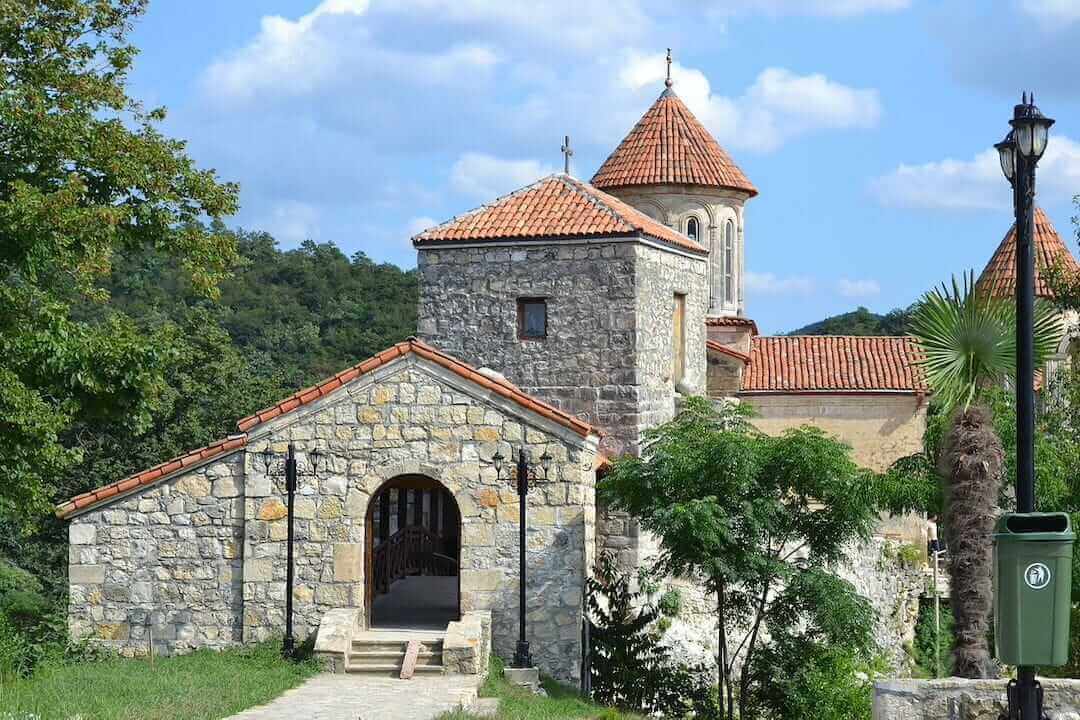
Getting to Gelati and Motsameta Monasteries
Easy to reach by road, both monasteries lie a couple of kilometres off the M17 highway that runs northeast of Kutaisi. First is Motsameta Monastery, 7kms from Kutaisi (5kms on the main road and then a further 2kms once you’ve turned off it). Driving directly from Kutaisi, Gelati Monastery is 9kms by road (around half of that distance is once you take the monastery turn-off). Because neither monastery is located on the main road, the distance between them is around 6kms.
The most convenient way to visit both monasteries on the same trip is to either take a tour or hire a car and driver locally to take you to them, wait while you visit, and return you to your base.
Although more time-consuming, it is possible to visit both locations using public transport, however. Marshrutkas depart Kutaisi for Gelati Monastery from a lot on Varlamishvili Street (see map for exact location). According to our notes (although it is best to check locally with the tourist board) they leave at 8am, 11am, 2pm, 4pm and 6pm. The same marshrutkas pass the turn-off for Motsameta Monastery, which is 1.8kms off the Gelati road. It is probably best, however, to travel to the furthest point and visit Gelati Monastery first, the reason being that if public transport is thin on the ground coming back in the reverse direction, it is feasible to walk from one monastery to the other. The distance is 6kms and it takes around up to an hour and a half depending on your pace. Most importantly, if going from Gelati to Motsameta the walk is mostly downhill.
When you are finished at Motsameta Monastery, you need to return to the main road to catch transport heading back to Kutaisi.
If you are comfortable with it, another option is to hitch a ride on all or some of the return legs. We are by no means serial hitchers but have thumbed a lift in, not only Georgia but other regions of the Caucasus, on numerous occasions and have got to see places that we never thought we would reach without our own transport. I suspect the route from Gelati Monastery to Kutaisi would be an easy one to hitch, especially on the weekend and Sunday in particular given both monasteries are still active.
Chiatura
Chiatura is a mining town located 70km east of Kutaisi. Although it takes more time to reach on public transport, like Tskaltubo, Chiatura makes for an absorbing day excursion from Kutaisi and is well worth squeezing into your itinerary.
Riding in a rusting Soviet-era cable car, or an ‘iron/death/flying’ (take your pick!) coffin as they were also known, used to be the town’s star attraction. However, the original cable car system has now ceased operating and has been replaced with a modern French-designed and constructed aerial tramway network.
No doubt this has put off some potential visitors but, as our more detailed post about Chiatura highlights, there is a plethora of things to see and do in and around the town making it not just a decent day trip ex Kutaisi but a worthy destination in its own right. Taking a ride on at least one of the four new cable car lines provides fantastic vistas of the town below, plus there are still a few of the photogenic original cable cars hanging around and a handful of the original stations that are worth searching out. There are also examples of Stalinist Empire style and Soviet Modernist architecture scattered around town, a large memorial to the Great Patriotic War and some impressive monumental art in the form of Soviet-era mosaics.
Regular marshrutkas depart from Kutaisi’s main bus station for Chiatura. The journey time is in the region of 1.5 to 2 hours. Keep in mind the last marshrutka back to Kutaisi leaves Chiatura at around 5pm so if you want to see everything we mention in our post you will have to make an early start or, alternatively, spend the night there.
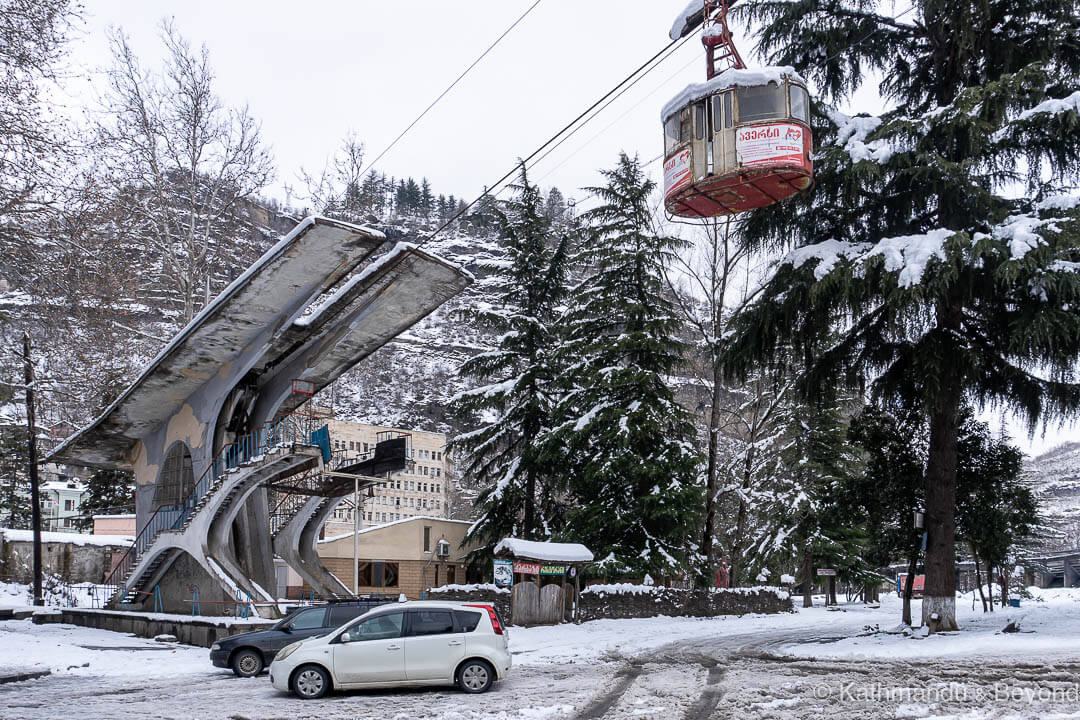
Batumi and Borjomi
Although some articles and travel blogs suggest the Black Sea city of Batumi and the resort town of Borjomi as feasible day trips from Kutaisi, we would recommend against visiting either in this way if using public transport. The travelling time from Kutaisi to both destinations is at least 2.5 hours one way and, this doesn’t allow enough time to do either place justice. Borjomi warrants at least an overnight and it is easy to spend two or three days discovering what Batumi has to offer.
How to get to and from Kutaisi
Kutaisi is easily reached from most places in Georgia either by bus, marshrutka or train. The Visit Kutaisi website used to have a great list of routes and timings but sadly that’s no longer the case. We recommend you check directly with their office near Rusaveli Bridge or at the bus station.
Kutaisi local bus and marshrutka schedules on WikiRoutes
Georgian Railways (although the app is easier to use for checking tickets)
If you found our guide to things to do in Kutaisi helpful, please share it…
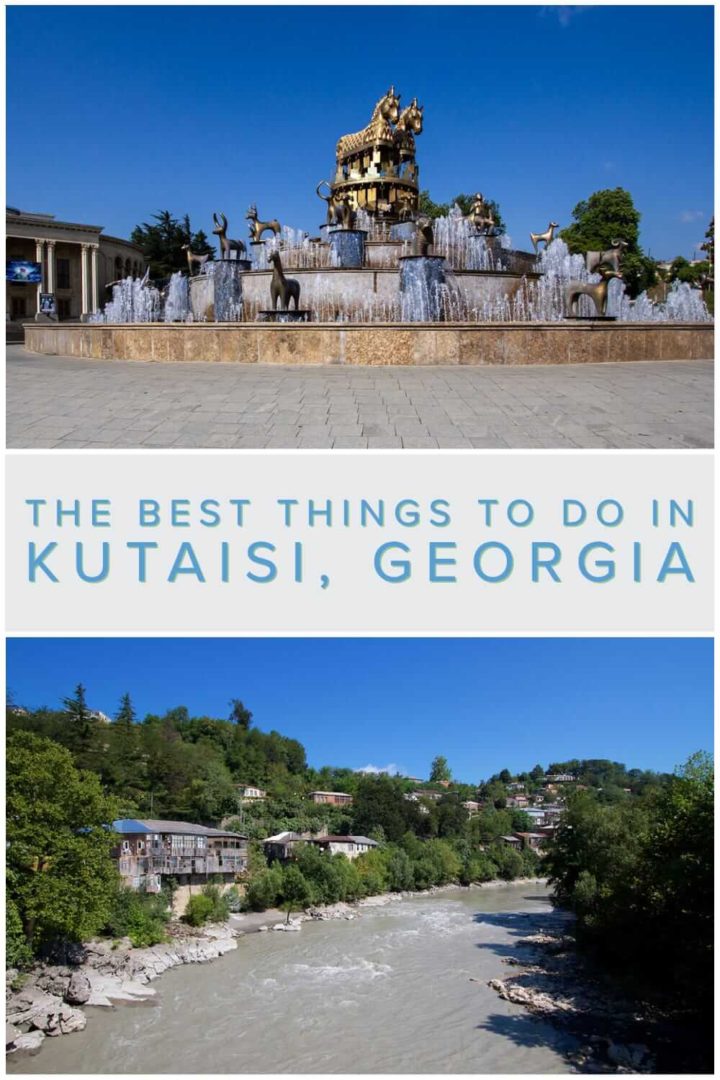
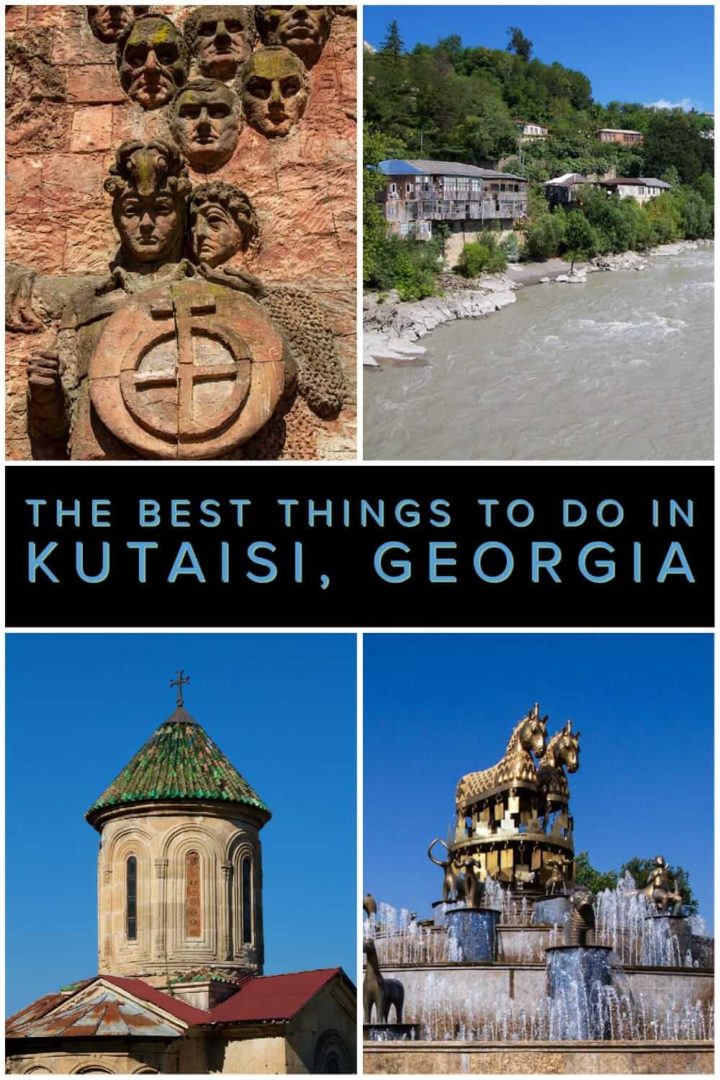
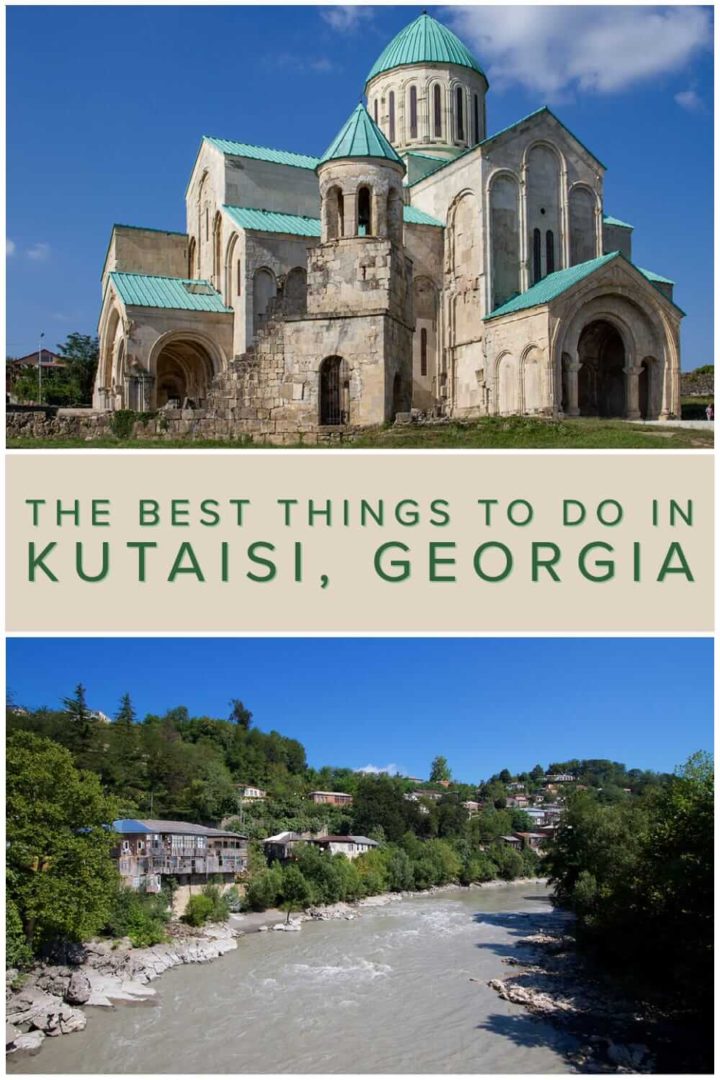

The blog post on things to do in Kutaisi, Georgia is a great resource for travelers looking to explore this beautiful city. I particularly enjoyed the section on the Gelati Monastery, which sounds like a fascinating place to visit.I’m curious to know if there are any other hidden gems in Kutaisi that you recommend checking out?
Glad you enjoyed the post. We also have one about Soviet-era architecture, monuments and mosaics in Kutaisi.
https://www.kathmanduandbeyond.com/soviet-architecture-monuments-mosaics-kutaisi-georgia/